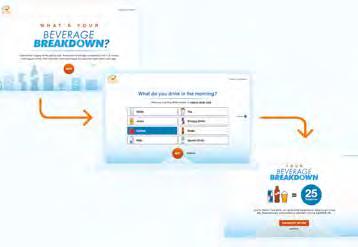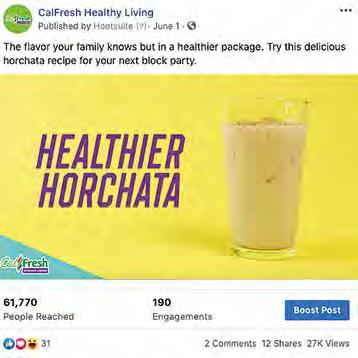
12 minute read
Branding for People Not Topics
‘Branding for People Not Topics’ What public health nutiton can learn fom commercial marketng
Shiloh Beckerley, Jef Jordan Rescue Agency, San Diego, CA, USA
Advertisement
Key messages
> Commercial marketing is ofen based on segmentation by psychographics: frst, understanding the drivers and values of specifc target audiences, and then leveraging those insights to design messaging that is inherently appealing to specifc audiences. that rate in the USA. 1,3 Challenges such as lack of access, food insecurity, food environment and policies have created a breeding ground for both undernutrition and obesity that disproportionately afects vulnerable populations around the globe. 4–7
> Public health authorities can make nutrition messaging more appealing by employing a similar psychographic segmentation and message design model.
> When developing psychographic-based nutrition messaging, it is important to understand the varied functions that food serves in diferent people’s lives. To be efective, nutrition messaging must be based in each audience segment’s real-world scenarios and must ofer advice that makes sense within their routines and realities.
> Making messages SAVI: Specifc, Acceptable, Viable and Impactful ensures message efectiveness.
While remarkable progress has been made globally to reduce rates of hunger and undernutrition during recent decades, malnutrition, in all its forms, continues to impact every country. Virtually all high-income countries are experiencing staggering rates of overweight/obesity, while in many low- and middle-income countries overweight/obesity exists side by side with undernutrition. 1,2 Malnutrition is a systemic problem. Extensive research supports what we know intuitively – that a simplistic explanation of a ‘lack of willpower’ fails to account for obesity rates reaching one in eight adults globally, and over three times These systemic issues are compounded by food companies that target the same vulnerable populations, inundating them with messages that promote unhealthy foods, such as sugary beverages, fast food and empty calorie snacks. 8–12 To increase the appeal of these unhealthy choices, companies use sophisticated segmentation techniques that leverage information about people’s motivations, lifestyles and social patterns. 9 Consequently, vulnerable populations are not overweight because they want to be that way; they’re overweight because in this landscape it is challenging to see another viable option. Instead of providing realistic opportunities, traditional public health campaigns have too ofen focused on simply telling people they should be healthier. Doing so completely misses the mark; people already know they should change. What they don’t know is how to change within the confnes of their personal situations.
lack the specifc knowledge and tools to take action. To provide a clear road map to healthy living, Rescue breaks down generic nutrition messages using its SAVI messaging approach (see Box1). This approach ensures that our audiences do not shoulder the burden of fguring out how to make healthier nutritional choices by themselves.
box1: Rescue Agency’s SAVI messaging approach
Specifc Must include a specifc example of what our audience can do to change their behavior
Acceptable Must be acceptable within the cultural, familial and social contexts of our audience’s lives
Viable Must be possible within the constraints of our audience’s available time, budget and skills
Impactfl If adopted, the message would cause a meaningful impact on the audience’s nutrition
By defnition, SAVI messages must be tailored to the audience. Diferent groups of individuals display, for example, variation in the skills they bring to the table, impacting viability. They have unique behavioral patterns and need to change their nutrition behaviors in diferent ways. Thus, it is not possible to fnd a single nutrition message that will work across all audiences. To ensure we are reaching audience members with messages that resonate, Rescue tailors creative materials to audience segments, identifed through psychographic segmentation – a strategy that food companies rely on in commercial marketing (see Box 2). 9 Forming a deep audience understanding through psychographic segmentation The process of psychographic segmentation, in which an audience is divided into distinct subgroups using values, attitudes, lifestyles or interests, benefts fom a mixture of methodologies. At Rescue, we lead with rich, qualitative research, ensuring we have the opportunity to investigate participants’ values, or other characteristics, that are most important to them. In-home ethnographic interviews are particularly usefl, as the home ofen reveals critical behaviors and habits that participants ofen forget to tell researchers. This format allows researchers to directly observe participants’ home food environment, while probing about the diverse and complex fnctions that diferent food choices serve. Researchers take notes and photos, recording not only which foods are present, but also the positioning and quality of the foods they see. For example, they document when boxes of sugary cereals are stored prominently on the top of the fidge, and note when lettuce is wilted and crammed in a fidge drawer. Interviews are followed by focus groups that are stratifed so that individuals with common motivations are grouped together. This allows participants, hypothesized to be in a common psychographic segment, to engage in discussions about their core values and barriers to healthy eating. Researchers then administer a larger-scale online survey to test theorized segments and estimate the size of each group.
Emerging value-based segments Across low-income adult populations that Rescue has worked with, consistent commonalities and distinctions in core values have led to the identifcation of six core motivational drivers: Personal Ambition, Stability-Seekers, Caring for Others, Experiences and Sensation-Seeking, Seeking Knowledge and Learning, and Building a Respected Reputation. Of those, three segments make up the largest portion of the low-income
box2: Overview of branding for people, not topics
Branding for people: the approach > Form a deep understanding of the audience through psychographic segmentation
> Apply audience insights to develop tailored messages that are authentic and impactful
> Instead of delivering messages that tell audiences they should be healthier, deliver SAVI messages that show audiences how they can make realistic, impactful changes © Rescue Agency on behalf of the Colorado Department of Human Services
box3: Real-world examples of those driven by Personal Ambition, Stability-Seekers and Caring for Others
Personal Ambition

Julia spends her days bouncing back and forth between her day job at a clothing store and evenings at beauty school. She views school as a stepping-stone towards her long-term plan of starting a natural beauty salon. She knows that she has a lot to fgure out – between sourcing the products and running the business – but she is confdent that she will get there. At night, she heads over to pick up her 3-year-old daughter from her mom’s apartment. Between work, school, her business and being a single mom, there isn’t a lot of time for much else, but she feels good knowing that she is working towards making a great life for herself and her daughter.
Stability-Seeker

Caring for Others

© Photographs: Rescue Agency
James was born and raised in a small town, where he still lives with his wife and four small children. He loves the familiarity of his town and couldn’t imagine ever leaving. A few years back, he and his family moved in with his parents so they could save for a house. While it was a tight ft, he feels that it was an important step to establishing security. When chatting about life in his town, he describes neighbors who like to go out in larger towns nearby on the weekends. He fnds these activities frivolous. He much prefers to do what he and his family do every weekend: buy three US$5 cheese pizzas and watch a movie at home. Afer all, it is what they always do, and James likes to think “If it’s working, why change it?”
Maria lives in a small house in an urban center with her four children, ranging in age from eight to 17. When she talks about how much she loves taking care of her children, she lights up and smiles brightly. She takes a two-hour bus ride to and from work each day, but always comes straight home from the bus stop, because her kids need her. Weekends center around her husband. Every Saturday morning she travels to see her husband, who was deported almost 10 years ago, so that she can clean and prepare his favorite meals. She loves supporting and being there for her family, and is truly happiest when making life a little bit easier for those around her.
populations that Rescue has worked with, and also have the highest rates of obesity: Personal Ambition, Stability-Seekers and Caring for Others. Those driven by Personal Ambition are fture-thinking and hardworking. They are high-energy individuals, ofen balancing work, relationships and school. They view their low-income status as temporary and believe they are working towards improving their lives and the lives of their loved ones. Stability-Seekers strive to establish security for themselves and their loved ones. They fnd pleasure in routine, value tradition and generally like predictable outcomes. The third group, Caring for Others, takes personal responsibility for improving the wellbeing of others, particularly their kids, spouse and, if applicable, live-in-parent. They express a strong desire to make their family members happy by responding to, and anticipating, all their needs (see Box 3).
© Rescue Agency on behalf of the California Department of Public Health

‘Personal Ambition’ Instagram post, emphasizing novel favors that energize relatable, balancing multiple responsibilities and demonstrating the struggle of having limited time to achieve their goals. Those driven by Personal Ambition respond well to nutritional ‘challenges’ that leverage the audience’s goal-oriented nature. In contrast, messages that resonate with Stability-Seekers fame health as providing comfort and security. Stability-Seekers tend to connect with messages that emphasize how real health isn’t about one-of fads; rather it’s about using a step-by-step, moderate approach to change. Thus, messages should suggest incremental changes to traditional meals, using familiar ingredients. Characters should express the desire for security and the strong need to follow tradition. Stability-Seekers respond well to simple solutions, such as promoting the use of fozen produce. This alleviates their fears of produce spoiling and leans into Stability-Seekers’ desire to be prepared ‘just in case.’
Apply audience insights to develop tailored messages Insights about the values and priorities of each psychographic segment obtained through the research process are used to tailor creative materials. Learnings about each segment are used to ensure that characters and situations refect our audiences’ core motivations, struggles and unique barriers, while promoting nutrition messages that are SAVI. For example, for those driven by Personal Ambition, health should be famed as a path towards a successfl, smart fture. Messages should express how the ability to eat well and be ft isn’t about putting in more time and energy; instead, it’s about gaining an edge to achieving their goals. Characters should be

Highly tailored digital experience during which participants report their beverage consumption habits, are educated about their personal sugar intake and are then guided through selecting lower-sugar alternatives

© Rescue Ag ency on behalf of the California Department of Public Health
Finally, messages that connect with the Caring for Others segment position working towards health as a family, happy and together. Messages should communicate that healthy meals don’t have to create confict between parents and children, but can be a ‘unifing’ activity that benefts everyone. Characters should prioritize family and the desire to maximize quality family time. As this segment is highly concerned with ensuring meal options are well received by the entire family, messages should suggest fn, kid-fiendly, kid-tested recipes.
Conclusion Efective marketing communications go beyond just telling someone what they should do. Efective marketing refects the audience’s reality, and shows that healthy nutrition can not only ft within their lives, but that it can improve their lives in ways that are important to them – for example, moving them closer to their goals, increasing their sense of security or showing their families how much they care. This is how we take on the burden of change. At every step at Rescue, we seek to understand our audiences on a fndamental level, developing authentic, tailored messaging that supports positive behavior change. While this is just a single aspect of tackling the complex puzzle that is obesity prevention, it is a key frst step in empowering people to improve their own lives.
Correspondence:Shiloh Beckerley, Rescue Agency, 2437 Morena Blvd, San Diego, CA 92110, USA Email: sbeckerley@rescueagency.com
References 01. FAO, IFAD, UNICEF, WFP, WHO. The state of food security and nutrition in the world 2018. Building climate resilience for food security and nu trition. Rome: FAO; 2018. 02. World Health Organization (WHO). The double burden of malnutrition. Policy brief. Geneva: World Health Organization; 2016. 03. Hales CM, Carroll MD, Fryar CD, Ogden CL. Prevalence of obesity among adults and youth: United States, 2015–2016. NCHS D ata Brief No. 288. Hyattsville, MD: National Center for Health Statistics; 2017.
04. Ghosh-Dastidar B, Cohen D, Hunter G, Zenk SN, Huang C, Beckman R, et al. Distance to store, food prices, and obesity in urban food deserts. Am J Prev Med. 2014;47(5):587–95. 05. Steeves EA, Martins PA, Gittelsohn J. Changing the food environment for obesity prevention: key gaps and future directions. C urr Obes Rep. 2014;3(4):451–8. 06. Tanumihardjo SA, Anderson C, Kaufer-Horwitz M, Bode L, Emenaker NJ, Haqq AM, et al. Poverty, obesity, and malnutrition: an international perspective recognizing the paradox. J Am Diet Asso c. 2007;107(11):1966–72. 07. Cairns G, Angus K, Hastings G, Caraher M. Systematic reviews of the evidence on the nature, extent and efects of food marketing to children. A retrospective summary. Appetite. 2013;62:209–15. 08. Yancey AK, Cole BL, Brown R, Williams JD, Hillier AM, Kline RS, et al. A cross-sectional prevalence study of ethnically targeted and general audience outdoor obesity-related advertising. Milbank Q. 2009;87(1):155–84. 09. Grier SA, Kumanyika SK. The context for choice: health implications of targeted food and beverage marketing to African American s. Am J Public Health. 2008;98(9):1616–29. 10. Powell LM, Wada R, Kumanyika SK. Racial/ethnic and income disparities in child and adolescent exposure to food and beverage television ads across the US media markets. Health Place. 2 014;29:124–31. 11. Cassim SB. Food and beverage marketing to children in South Africa: mapping the terrain. S Afr J Clin Nutr. 2010;23(4):181–5. 12. Menger-Ogle AD, Johnson AN, Morgan JA, Graham DJ. Television advertising of food during children’s programming in Nepal. Nutrition. 2018;55:41–4.









